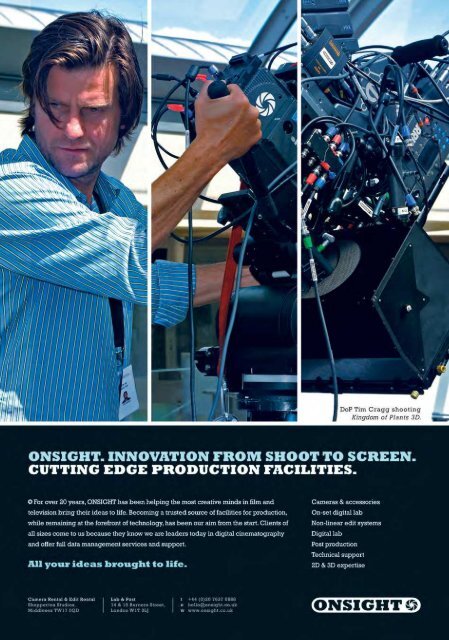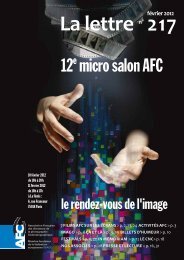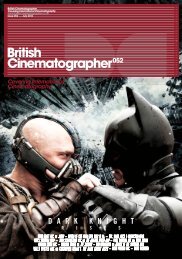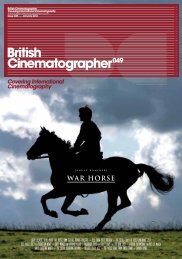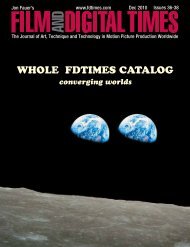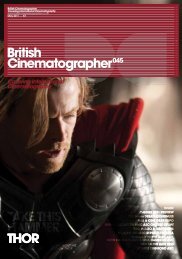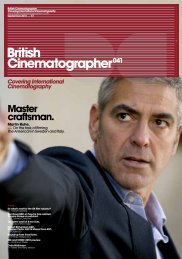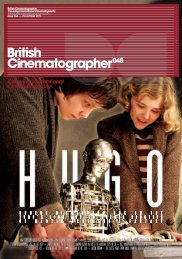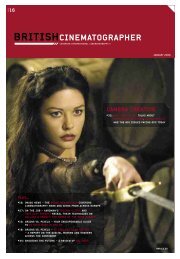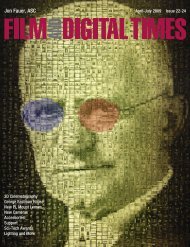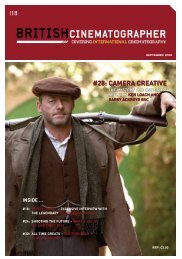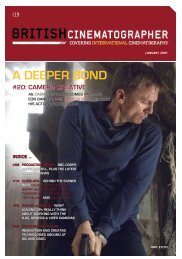British Cinematographer issue 51 - Imago
British Cinematographer issue 51 - Imago
British Cinematographer issue 51 - Imago
Create successful ePaper yourself
Turn your PDF publications into a flip-book with our unique Google optimized e-Paper software.
<strong>British</strong> <strong>Cinematographer</strong><br />
22<br />
Covering International Cinematography<br />
www.britishcinematographer.co.uk<br />
Issue 0<strong>51</strong> ––– May 2012<br />
Section<br />
–––Person’s Name BSC<br />
Project Line1<br />
Line2 Project<br />
<strong>British</strong> <strong>Cinematographer</strong><br />
Covering International Cinematography<br />
www.britishcinematographer.co.uk<br />
Issue 0<strong>51</strong> ––– May 2012<br />
Close-Up<br />
–––Caleb Deschanel ASC<br />
Abraham Lincoln: Vampire Hunter<br />
Abraham Lincoln: Vampire Hunter takes audiences<br />
on a journey to a time when the legendary American<br />
president was fighting for the survival of his nation. The<br />
enemies are vampires who are plotting to take over<br />
the country. The independent feature is based on a<br />
best-selling novel written by Seth Grahame-Smith who<br />
co-authored the script.<br />
Lincoln was born in 1809 in a one-room log cabin<br />
on a farm in Kentucky. His mother died under suspicious<br />
circumstances when he was ten years old. Lincoln<br />
overcame formidable obstacles on his path to being<br />
elected president in November 1860. The Civil War began<br />
five months later when ten southern states seceded from<br />
the union. On January 1, 1863, President Lincoln <strong>issue</strong>d<br />
The Emancipation Proclamation, which freed the slaves.<br />
The script authored by Grahame-Smith is true to<br />
history with the exception of the role that vampires play.<br />
Lincoln’s battle with vampires begins when one of them<br />
kills his mother.<br />
Caleb Deschanel ASC brought a broad base of<br />
eclectic experience to the project. He earned BSC<br />
and BAFTA award nominations for his first film, The Black<br />
Stallion, in 1979. Deschanel subsequently earned Oscar<br />
nominations for The Right Stuff (1983), The Natural (1984),<br />
Fly Away Home (1996), The Patriot (2000) and The Passion<br />
Of The Christ (2004). His peers lauded him with the ASC<br />
Lifetime Achievement Award in 2010.<br />
Abraham Lincoln: Vampire Hunter was Deschanel’s<br />
first collaboration with director Timur Bekmambetov, who<br />
began his career in Russia. His credits in his native land<br />
include several vampire films. Bekmambetov migrated<br />
to the United States in 2005.<br />
The aesthetic challenges were creating images<br />
which transport audiences to the places and times<br />
where and when the story unfolds, whilst making<br />
Lincoln an empathetic character. Deschanel sought<br />
visual references in libraries and book stores. He found<br />
approximately 25 books with pictures taken during the<br />
Civil War and of Lincoln at various times in his life.<br />
“Matthew Brady, Timothy O’Sullivan and other<br />
great photographers took amazing photographs,” he<br />
says. “It wasn’t like taking pictures today. They had to<br />
coat a piece of tin with caladium, which is kind of like<br />
a glue, and dip it in a silver nitrate solution in the dark.<br />
They put it in the camera and recorded a picture on<br />
it. Then, they took it out and developed it. They had<br />
to develop it pretty quickly before it set, because<br />
otherwise the image would be lost.”<br />
Deschanel says that composing the film in wide<br />
screen 2.4:1 aspect ratio was an obvious decision,<br />
because backgrounds on battlefields and other<br />
scenes are like characters in the story. Most of the<br />
story takes place in Illinois, where Lincoln was raised,<br />
and in Washington DC.<br />
Abraham Lincoln: Vampire Hunter was produced at<br />
practical locations in New Orleans and other places in<br />
Louisiana. Some sets were built in a former warehouse.<br />
An important scene takes place on a cliff overlooking<br />
a riverbed. The second unit shot background footage<br />
on location and facing an artificial cliff that was built<br />
behind the warehouse.<br />
“We found appropriate locations, and when<br />
necessary, (production designer) François (Audouy)<br />
altered them so that they felt right for the time and<br />
place,” Deschanel says. “Our motivation for lighting was<br />
dictated by the period. If it was night, it was candlelight.<br />
If it was day, it was daylight. François and I got along<br />
really great. He made some alterations to the size of<br />
windows and the placement of things to accommodate<br />
lighting. Paul Olinde (gaffer) and I worked on lighting<br />
that would create a feeling of firelight with the right<br />
flickering effect.”<br />
Close Ups were written by Bob Fisher, Kevin Hilton and Michael Burns.<br />
Benjamin Walker was cast in the role of Lincoln,<br />
whose face during his adult life is familiar to American<br />
and other Western audiences. The audience sees much<br />
of the story through his eyes. Deschanel cites his close<br />
collaboration with make-up designer Greg Cannom,<br />
who he credits with playing an important role in defining<br />
the transformation of Lincoln from boyhood to manhood,<br />
leading up to the day when he came on the set with a<br />
full beard. There were similar challenges making actors<br />
cast in the roles of vampires look and feel real.<br />
“I brought George Scali onboard as the second<br />
unit cinematographer,” Deschanel says. “He and his<br />
crew worked on battle sequences and things we<br />
didn’t have time to shoot. George was my assistant<br />
cameraman earlier in his career. He worked with<br />
the stunt people on some of the action sequences<br />
during the Civil War, and also some of the battles with<br />
the vampires. George did a terrific job of keeping<br />
everything in the style of what we were doing.”<br />
Abraham Lincoln: Vampire Hunter was primarily<br />
produced in digital format with ARRI Alexa cameras.<br />
Deschanel generally covered scenes with two cameras,<br />
sometimes more, depending upon the action. He<br />
generally kept the cameras at a similar angle to keep<br />
lighting consistent, rather than at cross angles.<br />
“A lot of the film was shot with cameras on dollies<br />
and cranes,” he says. “When we got into battle and<br />
other action sequences, it was much more handheld.”<br />
Action and other scenes that take place in slowmotion<br />
were recorded on Kodak Vision 5219 500T and<br />
Kodak Vision 5213 200D 35mm color negative film<br />
with ARRI 435 cameras. Deluxe Lab, in Los Angeles,<br />
processed the negative and provided dailies on BluRay<br />
DVDs. Deschanel had a projector and a six foot-wide<br />
screen in his hotel room. “At the end of the week, my<br />
crew and I watched dailies together,” Deschanel says.<br />
After editing was completed, Deschanel timed<br />
the digital intermediate with colorist Dave Cole at<br />
LaserPacific in Los Angeles.<br />
“To me, a movie doesn’t exist until it’s edited,”<br />
Deschanel says. “The way it’s cut affects every scene.<br />
Until you see that, you can’t make final decisions about<br />
the look. Benjamin Walker is great in the role of Abe<br />
Lincoln. You feel like you are there when he delivers the<br />
Gettysburg Address. Martin Csokas plays one of the<br />
vampires. That aspect of the movie takes on a life of<br />
it’s own. It was kind of fascinating making a historical<br />
film with vampires. The challenge was finding the right<br />
balance of the two genres.”<br />
Twentieth Century Fox has the film scheduled for<br />
release in late June 2012.<br />
Images courtesy of Owen Roizman ASC.<br />
23


